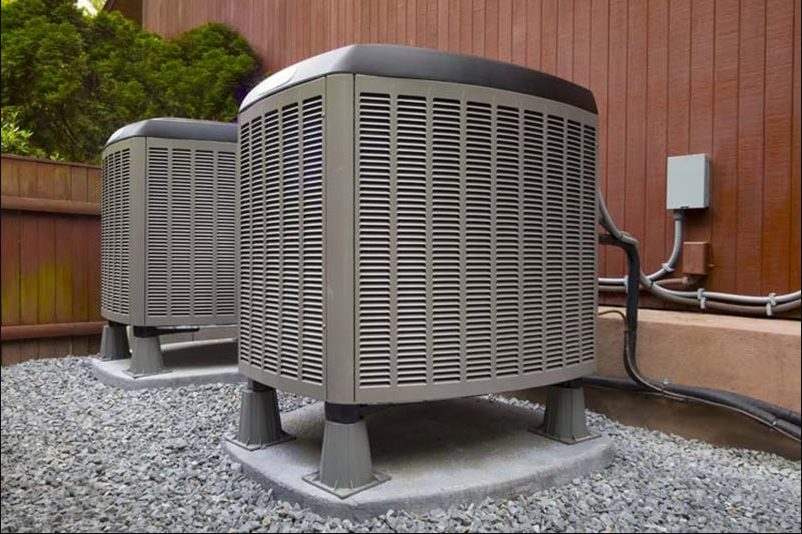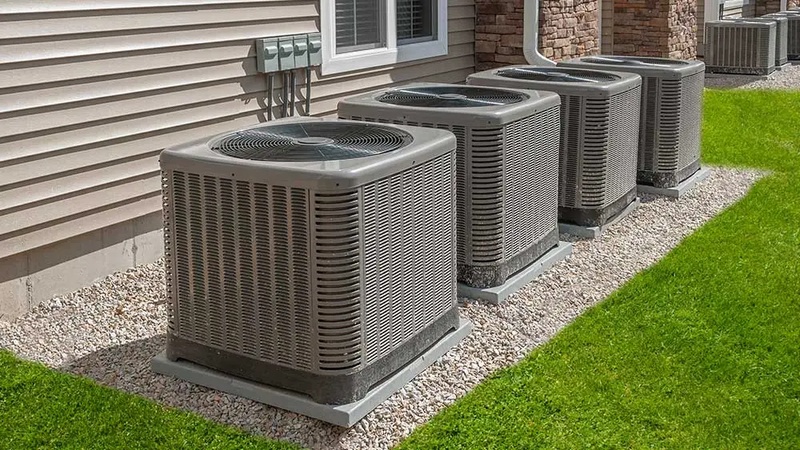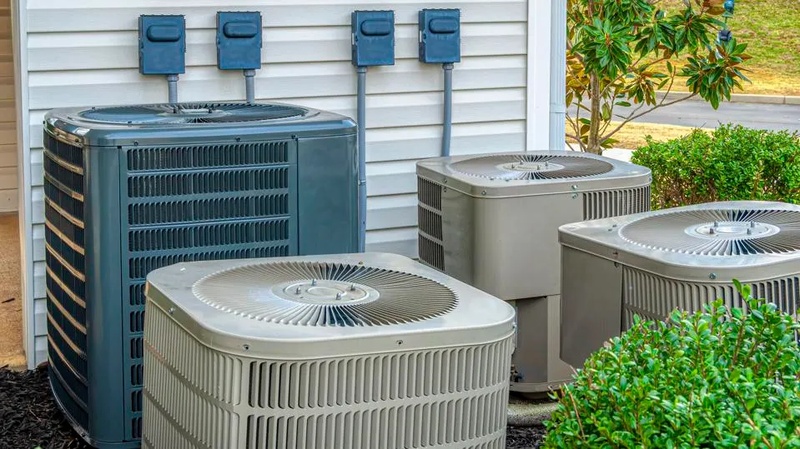
The cost of installing a central air conditioning system in a U.S. home ranges in thousands of dollars. The national average with both the unit and professional labor is approximately $5,000-6,000 and the total cost is usually $3,000-8,000 and above.
Central AC Cost by Unit Size (Tonnage)

One of the key expenses is the size of your air conditioner. We gauge central air units in tons. One ton is able to cool 12,000 BTUs an hour. Therefore, the larger the house, the larger the tonnage and the larger the ACs are, the more they cost to purchase and install.
Residential central airs are commonly available in 1.5 to 5 tons. A 400-600 square feet house may require 1.5 tons, a bigger house may require 5 tons. Insulation and climate also count.
Here is the average price of installation of the central AC units of some of the most common sizes (this is the price of the unit and the average labor price of installation):
| AC Unit Size | Installed Cost Range |
|---|---|
| 1.5 ton | $2,000 – $5,000 |
| 2 ton | $2,500– $5,500 |
| 2.5 ton | $2,700 – $6,000 |
| 3 ton | $3,000 – $6,500 |
| 3.5 ton | $3,100 – $7,000 |
| 4 ton | $3,500 –$7,500 |
| 5 ton | $4,000 – $8,000 |
An increase in the capacity of a system translates to an increase in cost.
To understand how, imagine a house that has 5-ton central AC. An installed cost of such a system would be approximately $4,000-$8,000, but a smaller 1.5-ton unit in an apartment could be $2,000-$5,000.
The larger-tonnage units are more expensive to buy since they require bigger and heavier hardware that makes the installations more laborious. They also tend to require a bigger furnace blower or air handler that would be compatible with the AC.
Central AC Cost by Home Square Footage
The dimension of your house influences the cost of central air installation. The larger the house, the larger the air conditioner required to cool the house.
To find out the right size of the unit you require, a professional has to perform a load calculation. but you may observe these crude principles:
| Home Size (Sq. Ft.) | Recommended AC Size | Installed Cost Range |
|---|---|---|
| 1,000 | 1.5 – 2 tons | $2,000 – $5,500 |
| 1,500 | 2.5 – 3 tons | $2,700 – $6,500 |
| 2,000 | 3.5 – 4.5 tons | $3,100 – $7,800 |
| 2,500 | 4.5 – 5 tons | $3,700 – $8,000 |
| 3,000 | ~5 tons | $4,000 – $8,500 |
The typical 2,000 square feet house would require an AC system of 3.5 to 4 tons. The cost of installing it is approximately between 3,100 and 7,800 dollars.
Don’t Overpay for HVAC Services – Call 888-894-0154 Now to Compare Local Quotes!
A 1,000 square feet house with a smaller size might require a 2-ton AC unit that is installed at a cost of $2,000 to $5,500.
You might require more than one AC or even a zoned system to make each room comfortable in case your house is larger than 3,000 square feet. These additional units increase the prices out of the scope mentioned above.
A professional HVAC contractor will perform a Manual J load calculation to select the proper size of your AC that depends on the climate of your region, the insulation of your home, and the design of your house.
Sizing matters. An oversized AC will turn on and off frequently, a waste of energy and a wear on the parts. An undersized AC will operate continuously and will not be able to cool the house.
Central Air Conditioner Prices by Brand

The prices of central air conditioner (AC) vary with brand. There are numerous good brands of ACs available in the United States and the price may vary depending on the quality, warranty and additional features.
The premium brands such as Trane, Carrier and Lennox tend to be more expensive, whereas the value brands such as Goodman may be less expensive on the same-sized unit. The mean cost (with installation) of a 3-5 ton central AC of some of the leading brands is indicated below:
| Brand | Installed Cost Range |
|---|---|
| American Standard | $3,800 – $8,000 |
| Carrier | $4,700 – $8,700 |
| Goodman | $3,200 – $5,000 |
| Lennox | $5,300 – $9,000 |
| Rheem (Ruud) | $3,600 – $8,500 |
| Trane | $4,000 – $9,000 |
Luxury brands like Lennox and Carrier brands are normally more costly. A brand like Goodman is at the low end of the price.
Lennox systems can be installed at a cost of around $5,000-$9,000 as compared to Goodman central ACs that can be installed at $3,000-5,000 in the same scenario.
Between those two there is a middle ground brand such as Rheem or American Standard. The truth is that most brands share very similar internal components (Trane and American Standard are sister companies) and paying more does not always mean a radically better performance, but it can mean different features, better build quality or warranty support.
Energy Efficiency (SEER) and High-Efficiency vs Standard Models
The cost is also determined by the air conditioner energy efficiency. The efficiency of energy is rated using SEER (Seasonal Energy Efficiency Ratio). The newer models are the 14 SEER to the 20-26 SEER on the most efficient models.
The higher the SEER, the more cost of purchase. High-SEER units also have advanced two-stage and variable-speed compressors, which are more costly than the basic single-stage compressors.
As an example, a basic 14 SEER central AC might run between approximately $2,500 – $6,000 installed, and a very high efficiency 21+ SEER unit of the same size might run $4,000-$10,000 or more.
The advanced compressors and other energy saving technology are the sources of the higher prices. An extremely effective AC model can nearly increase the price of a basic one by two-fold. The cost of purchase needs to be compared with the potential long-term energy savings by the homeowner.
There is money saved in the long run with high-efficiency systems. A super-efficient AC consumes less energy to cool your house and this reduces your monthly power bill.
The increased cost of purchasing AC might not be recouped by energy savings in case you use it occasionally or intend to change the place of residence shortly.
The middle-of-the-road efficiency of approximately 15-17 SEER is usually a nice compromise between the initial cost and a long-term savings.
The federal government increased the minimum SEER of new central ACs to 14 in the north and 15 in the south in 2023. The new AC that you purchase must be moderately efficient, although it is not a premium one.
Government and utility rebate and tax credit programs are available on some high-efficiency HVAC systems. These incentives may enable you to save money.
See what incentives exist to assist in paying the increased cost of a high-SEER unit or an ENERGY STAR 174-rated unit.
Existing Ductwork vs. New Ductwork Installation

Forced-air HVAC requires ducts to perform. These ducts already exist in a furnace or in an earlier central-air system, so a new AC can be connected to them with some minor adjustments. You will pay mostly on the AC unit and the labor to install it. These minor modifications can be in form of sealing minute leaks or inserting a vent which is not expensive.
Don’t Overpay for HVAC Services – Call 888-894-0154 Now to Compare Local Quotes!
In case you do not have ducts in your house, say it has baseboard heat or an older system without central air, your cost will be much greater since ductwork will have to be installed. Construction of new ducts is time consuming. Contractors might need to open up walls or ceilings, install ductwork in attics or crawlspaces and install supply registers in each room. This may cost extra thousands of dollars on the materials and labor bill.
Installing central air with brand-new ducts may be two times more expensive than installing a new AC in the old ducts. The average cost in the country is between $6,000-1$2,000 with new ductwork and $2,500-$7,500 with already existing ducts.
The cost of retrofitting ducts is not only high in terms of the labor but also due to the fact that it may require days and additional manpower.
When ducts are installed, it is simpler to install a furnace or a heat pump to have a central heating.
In the case where there are no ducts and the only requirement is air conditioning, the ductless mini-split system can be used to cool one room or zone without the need of major remodeling.
But when the target is central air and ducts are not available, then you need to be ready to pay more.
Installation Labor and Additional Costs
The price of a professional HVAC installation is composed mostly of labor costs. HVAC technicians on average charge between 75 to 150 dollars per hour.
It is a relatively easy job; it involves replacing or installing an AC unit to the existing ducts, and it requires one day or less, approximately 4 to 8 hours of labor by a crew.
A more complicated task, such as installing a new ductwork, working in an inaccessible attic, or upgrading other systems, may require 2-3 days.
Installation of a standard central AC normally costs 1,000 to 2,500 dollars of the total bill, though it may be more in case of a large job that is not a standard job. Location is also important, installations in cities where labor is more costly, and building codes more strict, will be on the high end of price scales compared to similar work in smaller towns.
The other expenses which ought to be taken into consideration are permits which are necessitated by numerous cities and counties to install or replace central HVAC systems. Permit fees are quite variable and are typically several hundred dollars to the job (250-400 dollars in most jurisdictions). Your HVAC contractor will do the process of pulling the permit and scheduling any inspection. After the installation has been done, the technicians will test and commission the new system- checking the refrigerant charge, airflow, thermostat communication and general performance which is usually included in the standard installation. The work may be planned at off-season when the bids are low.
To give an example, one of the national cost guides lists a central AC unit at about 3,900-7,900, installation labor at about 1,500, and permits at about 250-400, or a total of about 5,650-9,800 to install a complete unit with existing ducts. When new ducts are fitted, then the cost increases to approximately 10,770-15,060.
In case you are replacing an old air conditioner, you might be forced to pay the fee of removing and disposing of the unit. The old equipment will be removed free by most of the contractors otherwise, there can be extra cost (typically 100-300 dollars) to dispose the old AC and refrigerant in an appropriate way. This consists of legal necessity of safe recovery of refrigerant and disposal of the old unit.
Keep in mind regarding potential improvements or changes that can be necessary. The power may require an upgrade, a new dedicated circuit or a larger-amperage breaker to the AC, or, in the case of retrofitting central air to an old furnace, a new evaporator coil or blower motor may be required to get the system to work correctly. These are additional activities that will increase the cost in the event that they are relevant but they are not necessarily essential.
Being aware of all these factors, equipment and efficiency options, ducts, labor and extras, you will be capable of planning the total price of central AC installation without surprises.
Don’t Overpay for HVAC Services – Call 888-894-0154 Now to Compare Local Quotes!
Spending a little extra money on a well-known, experienced installer is generally a good idea; a good installation will ensure maximum efficiency and life of your AC, and it will be worth it even in case labor quote is a bit higher.
Tips for Saving on Central AC Installation
- Change your air conditioner during off-season. Do it either in the spring or the fall when the weather is mild. At these months, HVAC companies are less busy and thus you can get a cheaper price as compared to the highest charges during the summer. You can also receive special offers and be more flexible in the time when the work is going to be performed.
- Seek rebates or tax credit. Most utility companies and governments provide energy efficiency rebates on new high efficiency AC units. Such programs will save you hundreds of dollars.
- Never purchase a unit which is oversized to your house. Such a large unit will be expensive and it might short cycle, reducing its efficiency. Select a size that will fit your requirement.
- Have your furnace (or air handler) replaced as well. In case you have an old furnace, then it is worth replacing it with the AC unit. HVAC businesses can offer a single discount on the installation of both of them and can even match the equipment to ensure they all work together to be the most efficient.
- Seek at least three bids and then make your decision. To get three free estimates of local contractors, just click here. This service covers all the available rebates and tax credits and automatically sieves ineligible contractors.
- Once you have selected a contractor, use the tactics in this guide to obtain the best price: homeowners tactics when negotiating with HVAC dealer.
How to Get the Best HVAC Prices
- Firstly, keep in mind that installation quality is always the most important thing for residential HVAC project. So never sacrifice contractor quality for a lower price.
- Secondly, remember to look up the latest rebates as we talked above.
- Thirdly, ask for at least 3 bids before you make the decision. You can click here to get 3 free estimates from your local contractors, and this estimate already takes rebates and tax credit into consideration and filter unqualified contractors automatically.
Lastly, once you chose the right contractor, remember to use the tactics from this guide: Homeowners Tactics When Negotiating with HVAC Dealer to get the final best price.




